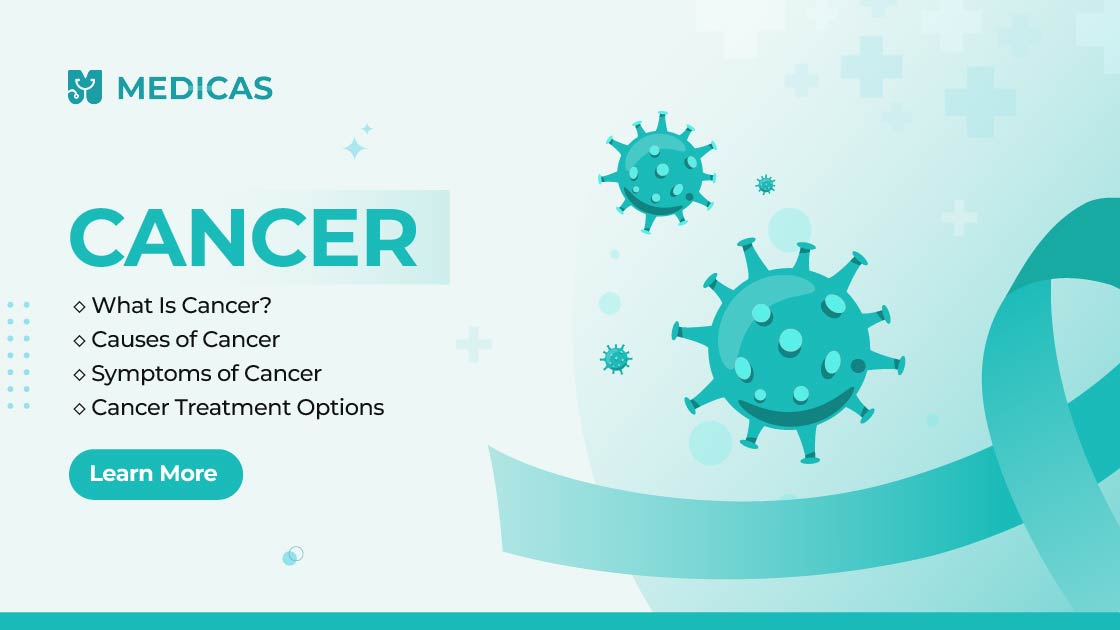A cancer diagnosis isn’t just a medical event—it’s a moment that changes everything. It can bring fear, confusion, and a thousand questions all at once. For many, it feels like their body has turned against them. For others, it’s the uncertainty that’s the hardest part—what happens next, where to go, who to trust?
Whether you or a loved one are facing cancer, or you’re here seeking answers, know this: understanding cancer is the first step toward reclaiming control. Because cancer isn’t just one disease—it’s a wide-ranging, complex condition rooted in how our own cells behave. And with the right information, early detection, and timely treatment, there is not just hope—but a clear path forward.
What is Cancer?
The cancer goes beyond just a tumor or lump—it’s the result of genetic mutations that cause cells to grow and multiply abnormally. Cancer can develop in almost any organ or tissue, including the lungs, breast, colon, skin, bones, and blood. It is one of the leading causes of death worldwide, but early detection and prompt treatment can significantly improve outcomes.
Causes of Cancer and Key Cancer Risk Factors Explained
There isn’t a single cause of cancer. It’s often a combination of factors, including:
- Genetic mutations: Changes in our DNA can lead to uncontrolled cell growth. These mutations can be inherited or acquired over time.
- Lifestyle factors: Smoking, excessive alcohol consumption, unhealthy diet, and lack of physical activity can increase cancer risk.
- Exposure to carcinogens: Radiation, certain chemicals, and chronic infections can damage DNA.
- Chronic inflammation and infections: Long-term infections like HPV and hepatitis B can increase cancer risk.
Understanding these cancer risk factors is essential for early prevention and proactive healthcare.
Early Signs and Common Symptoms of Cancer You Shouldn’t Ignore
Cancer symptoms can vary depending on the type or location of the cancer. Some general early signs of cancer include:
- Unexplained weight loss or gain
- Fatigue or low energy
- Persistent fever or night sweats
- Pain or tenderness in a specific area
- Changes in bowel habits
- Unusual bleeding or discharge
- Lumps or bumps anywhere on the body
Being aware of these early signs of cancer can lead to faster diagnosis and better outcomes.
Warning Signs of Cancer: When to Seek Medical Advice
While not all warning signs indicate cancer, some symptoms warrant urgent evaluation:
- A lump that increases in size over time
- A persistent cough or hoarseness
- Difficulty swallowing or persistent indigestion
- Sores that do not heal, especially in the mouth or skin
- Sudden changes in a mole’s shape, color, or size
If you experience any of these warning signs of cancer, it’s crucial to consult a healthcare provider promptly. Medicas offers you instant doctor consultations with leading oncologists from across the country. Consult Now on Medicas.
Types of Cancer: From Breast to Lung – Key Differences and Symptoms
Cancers are categorized based on the type of cell or tissue they originate from. Some common types include:
- Carcinomas: Originate from epithelial cells lining organs and skin. Examples include breast, lung, and colon cancer.
- Sarcomas: Develop in connective tissues like bones and muscles.
- Leukemias: Affect bone marrow and result in abnormal blood cell production.
- Lymphomas: Arise in the lymphatic system. Includes Hodgkin and non-Hodgkin lymphoma.
Symptoms of Breast Cancer: What to Watch For in Early Stages
Breast cancer symptoms vary by stage, but early detection can make a life-saving difference. Look out for:
- A lump or thickening in the breast or underarm
- Change in breast shape, size, or skin texture
- Nipple discharge or inversion
- Redness or flaking of the nipple or surrounding area
Regular breast exams and mammograms are essential for early detection.
Symptoms of Lung Cancer: Common Signs and Risk Factors
Lung cancer is often diagnosed in advanced stages because early symptoms may be subtle. Common signs include:
- Persistent cough or chest pain
- Shortness of breath
- Coughing up blood
- Frequent respiratory infections
- Hoarseness
Smoking is the leading risk factor, but non-smokers can also develop lung cancer.
How Cancer is Diagnosed: Tests and Early Detection Methods
Early detection and diagnosis are crucial for successful cancer treatment. Diagnostic methods include:
- Medical History and Physical Examination
- Imaging Tests: X-rays, CT, MRI, PET scans
- Biopsy: Definitive method to identify cancer cells
- Blood Tests: Including tumor markers
- Genetic Tests: Identify mutations for personalized treatment
- Endoscopy: Camera-based examination of internal organs
- Bone Marrow Aspiration: Especially for blood cancers
Cancer Treatment Options
The best cancer treatment depends on the type, stage, and individual health. Common options include:
- Surgery: To remove tumors
- Radiation therapy: Targets cancer with high-energy rays
- Chemotherapy: Drugs that kill cancer cells
- Immunotherapy: Boosts the body’s natural defenses
- Targeted therapy: Focuses on specific cancer cells
Note: Obtaining a second opinion in cancer care is a proactive and valuable step that can enhance the quality of diagnosis and treatment of your health and fight cancer with a more informed and confident approach.
Chemotherapy Side Effects: What to Expect During Cancer Treatment
Chemotherapy can cause side effects such as nausea, hair loss, fatigue, lowered immunity, and mouth sores. Newer regimens aim to reduce toxicity while remaining effective.
Radiation Therapy for Cancer: Benefits and Potential Side Effects
Radiation therapy can shrink or destroy tumors but may lead to skin irritation, fatigue, and localized swelling. It’s a highly targeted treatment often used before or after surgery.
Immunotherapy for Cancer: How It Works and Who It Helps
Immunotherapy helps your immune system recognize and fight cancer. It has shown promise in treating melanoma, lung, and bladder cancers, especially in patients with high tumor mutational burden.
Cancer Prevention Tips: Reduce Your Risk with Healthy Habits
While cancer cannot always be prevented, you can reduce your risk:
- Eat a diet rich in fruits, vegetables, and whole grains
- Avoid processed and red meats
- Quit smoking and limit alcohol
- Exercise regularly
- Maintain a healthy weight
- Get vaccinated for HPV and hepatitis B
- Use sunscreen and avoid tanning beds
Learn more
Watch this video to understand cancer better
Conclusion
Cancer is a complex disease, but early detection, lifestyle awareness, and proper treatment can improve survival and quality of life. From recognizing early symptoms to exploring advanced treatment options like immunotherapy, cancer awareness is your first defense. For personalized guidance or a second opinion, connect with an expert today.
For personalized guidance or a second opinion, connect with an expert today.
👉 Consult a doctor online now
👉 Book an appointment with a specialist
👉 View top oncologists (starting Rs. 500)
Frequently Asked Questions
What are the most common cancer symptoms to watch for?
Cancer symptoms vary by type, but some warning signs are common across many forms of the disease. These include unexplained weight loss or gain, persistent fatigue, unusual bleeding or discharge, lumps or swellings anywhere on the body, chronic pain that doesn’t go away, changes in bowel or bladder habits, and sores that don’t heal. If you experience any of these symptoms, especially if they persist or worsen, it’s important to consult a doctor promptly.
What are the symptoms of lung cancer and when should I see a doctor?
Lung cancer symptoms often include a persistent cough, coughing up blood, shortness of breath, chest pain, hoarseness, and frequent respiratory infections. In later stages, symptoms like weight loss and fatigue may appear. See a doctor if you have a cough that won’t go away, chest pain, or any breathing issues—especially if you’re a smoker or have a history of exposure to harmful substances.
What is radiation therapy and how is it used to treat cancer?
Radiation therapy uses high-energy rays (like X-rays or protons) to kill or shrink cancer cells. It can be delivered externally (from a machine) or internally (through radioactive implants). It’s often used alongside surgery or chemotherapy to treat localized cancers, relieve symptoms, or shrink tumors before or after surgery. Common side effects include fatigue, skin irritation, and localized discomfort, depending on the area treated.
How does chemotherapy work and what are its side effects?
Chemotherapy uses powerful drugs to target and kill rapidly dividing cancer cells throughout the body. It’s often used for cancers that have spread or cannot be treated with surgery alone. Side effects can vary, but common ones include nausea, vomiting, hair loss, fatigue, lowered immunity, and mouth sores. Newer regimens are more personalized, helping to minimize side effects while still being effective.
Related Blogs
Disclaimer
Medical Advice: The information provided in this blog post is for educational purposes only and should not be considered as a substitute for professional medical advice, diagnosis, or treatment. Always consult with a qualified healthcare professional for personalized guidance regarding your specific medical condition.
Accuracy of Information: While we strive to provide accurate and up-to-date information, the field of medicine and viral fevers is constantly evolving. The content in this blog post may not reflect the most current research or medical guidelines. Therefore, it is advisable to cross-check any information provided with reliable sources or consult a healthcare professional.
Individual Variations: The symptoms, causes, treatment options, and preventive measures discussed in this blog post are general in nature and may not apply to everyone. It is important to remember that each individual’s situation is unique, and personalized medical advice should be sought when making healthcare decisions.
External Links: This blog post may contain links to external websites or resources for additional information. However, we do not endorse or have control over the content of these third-party websites. Accessing these links is done at your own risk, and we are not responsible for any consequences or damages that may arise from visiting these external sources.
Results May Vary: The effectiveness of treatment options or preventive measures mentioned in this blog post may vary from person to person. What works for one individual may not work the same way for another. It is essential to consult with a healthcare professional for personalized advice tailored to your specific needs.

Dr. Murali serves as the Chief Medical Officer at EGS Health, bringing over 18 years of experience as a general practitioner to his role. He also directs Special Projects & Development at the Central America Health Sciences University, Belize Medical College. Dr. Murali holds an MD and a PG Cert in Health Profession Education (HPE) and has been an active contributor to the medical field since 2001. His career began in the Tobacco Cessation Program and the Border Family Welfare Programs in conjunction with PAHO in Ciudad Juarez, where he also published research on the impact of technology on healthcare education. He later became a clinical coordinator for clerkships, forging partnerships between students and hospitals that now serve as clinical sites for the university. Dr. Murali has furthered his expertise through advanced training, including the Leaders in Healthcare Education course at Harvard Macy Institute and the Health Professions Certification Program at Keele University, enhancing his influence in both medical education and healthcare delivery, both locally and internationally.


